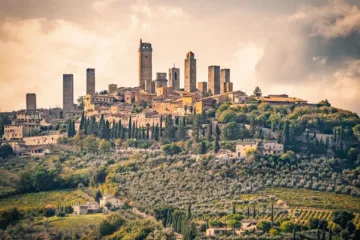
Gattinara is the best and longest standing example of Nebbiolo from northern Piedmont. For a long time, Gattinara was considered the most prestigious wine in Piedmont. The appellation suffered from a lengthy period of decline, but the best examples now merit the high reputation they once had.
A short history of Gattinara
Gattinara is a land with a historic viticultural culture. This region was planted with vines long before the Romans arrived. The wines of Gattinara started to be exported since the 14th century.
In the 16th century, Cardinal Marcurino Arborio, a native of Gattinara, brought the wine to the Imperial Court of Charles V, Holy Roman Emperor. As a result, the wines gained a reputation that lasted until the end of the nineteenth century.
The appellation was promoted from DOC to DOCG in 1990 due to its historical renown rather than the intrinsic quality of the wines at the time.
However, enormous qualitative breakthroughs have been made over the last two decades. Today, Gattinara proudly leads Alto Piemonte’s resurgence, producing some of the greatest Nebbiolo from this once prestigious winegrowing region.
Gattinara’s Location
The Gattinara appellation is located north the the Italian region of Piedmont. The Sesia River divides the Alto-Piemonte into two halves. Gattinara is located in the Vercelli province. The Vercelli province is located on the west bank of the Sesia River, whilst the Ghemme appellation (located in the Novara province) is located east of the same river.
Gattinara’s Climate
Gattinara’s climate is warmer than the hot and humid Po plain to the south. The proximity to Lake Maggiore and Orta, a smaller lake, also helps to regulate the climate.
The hills benefit from the cool air descending from the Alps as well as the temperature changes that occur throughout the day. For these reasons, Nebbiolo wines from this region are higher in acidity than those from the south.
More about Gattinara’s vineyards
The vine area remains tiny. The soils are the product of the disintegration of the volcanic porphyric subsoil.
Vineyards are cultivated on the steep hillsides behind the village of Gattinara, north of Vercelli, on the west bank of the Sesia River.
By regulation, vineyards must be planted exclusively on slopes with optimal exposure (facing west and southwest) at elevations ranging from 250 to 550 meters.
Compared to the other appellations in northern Piedmont, the Gattinara hills have the best natural conditions in terms of exposure, altitude, and soil mix.
This makes grapes easier to ripen, which explains its previous (and current) repute. Because Gattinara benefits from these advantages, the mandated minimum proportion of Nebbiolo is larger than in surrounding Nebbiolo-based appellations (for example Ghemme requires 85% minimum of Nebbiolo).
Growers have long been aware of the best vineyard parcels, and numerous producers now create single-vineyard bottlings dedicated to these terroirs. The most prestigious include Ossa San Grato, San Francesco, Castelle, Molsino, and Valferana.
Gattinara Grape Varieties authorized
The proximity to the Alps results in significant vintage variation. As a result, planting the late-ripening Nebbiolo grape variety in north of Piedmont and at such elevations is difficult. Because it is difficult to obtain full ripeness in the region, Nebbiolo has traditionally been softened by blending it with a small percentage of other red grape varietals.
Gattinara has to be made from at least 90% Nebbiolo grapes. The other grape varietals approved for mixing are Vespolina and Uva Rara. Together, they can make up no more than 10% of the blend, with Vespolina limited to 4%.
It is to be noted that the Nebbiolo grape variety is called Spanna in northern Piedmont (see ‘Other Nebbiolo biotypes‘ for other varietals).

Gattinara wine aging requirements before commercialization
When young, these wines are astringent and harsh. As a result, the Disciplinare requires at least 35 months of total aging, with a minimum of 24 months in oak.
Gattinara Riserva must be matured for at least 47 months, with 36 months under oak.
How Gattinara wines compare to other Nebbiolo wines
Gattinara wines benefit from lengthy bottle maturation, as do many other Piedmontese Nebbiolo wines. They also tend to age more slowly than other northern nebbiolos.
The best Gattinara wines have the classic Nebbiolo profile, with aromas of violet, brilliant red berry fruits, tar, spices, forest floor, and leather.
Because of the strong tannin and acid levels, the wines have a reputation for aging well.
Gattinara has a higher acidity than Langhe Nebbiolos, but a lighter color, body, and slightly lower alcohol content.

Follow me on my Social Media
Wine is a gourmet treasure, do not abuse alcohol!
None of this content has been sponsored
I did not receive any gifts or free samples that could be related to this article


